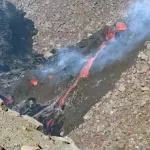The most recent information regarding Kīlauea’s current eruption is as follows:
Eruptive activity is confined to Halemaʻumaʻu crater within Kīlauea’s summit caldera. No unusual activity has been noted along Kīlauea’s East Rift Zone or Southwest Rift Zone.
Multiple minor fountains remain active on the southwestern Halema‘uma‘u crater floor and the vent on the southwest wall of the caldera continues to feed lava onto the westernmost part of the crater floor. Lava fountain heights have decreased since the eruption onset, but remain up to about 9 meters (30 feet) high. Active lava and vents cover much of the west half of Halemaʻumaʻu crater in a broad horseshoe around a central uplifted area. An active lava lake is centered within the uplifted area and is fed by a vent in its northeast corner. This feature is the “western lava lake” from prior eruptions that has been reactivated along with a smaller circular pool just southeast of the lake. The surface of the western lake rose approximately 1 meter overnight, probably due to construction of a levee around the pond. All previously active lava features in the eastern portion of Halemaʻumaʻu now appear to be stagnant. A live-stream video of the crater is available at https://www.youtube.com/usgs/live.
Summit tilt has remained deflationary over the past 24 hours. Summit seismic activity is dominated by eruptive tremor (a signal associated with fluid movement). Volcanic gas emissions in the eruption area are elevated; a sulfur dioxide (SO2) emission rate of approximately 8,900 tonnes per day was measured Friday, June 10, 2023. Observations from the KPCam on Mauna Loa Strip Road show the gas plume from Kīlauea rising to and remaining trapped beneath the inversion layer at 8,000 to 10,000 feet above sealevel.
No unusual activity has been noted along the East Rift Zone or Southwest Rift Zone; steady but low rates of ground deformation and seismicity continue along both. Measurements from continuous gas monitoring stations in the middle East Rift Zone—the site of 1983–2018 eruptive activity—remain below detection limits for SO2.
The eruption at Kīlauea’s summit is occurring within a closed area of Hawai’i Volcanoes National Park. High levels of volcanic gas—primarily water vapor (H2O), carbon dioxide (CO2), and sulfur dioxide (SO2)—are the primary hazard of concern, as this hazard can have far-reaching effects down-wind. As SO2 is continuously released from the summit during the eruption, it will react in the atmosphere to create the visible haze known as vog (volcanic smog) downwind of Kīlauea. Vog information can be found at https://vog.ivhhn.org/.
Additional hazards include Pele’s hair and other lightweight volcanic glass fragments from the lava fountains that will fall downwind of the fissure vents and dust the ground within a few hundred meters (yards) of the vent (s). Strong winds may waft lighter particles to greater distances. Residents and visitors should minimize exposure to these volcanic particles, which can cause skin and eye irritation.
Other significant hazards also remain around Kīlauea caldera from Halemaʻumaʻu crater wall instability, ground cracking, and rockfalls that can be enhanced by earthquakes within the area closed to the public. This underscores the extremely hazardous nature of Kīlauea caldera rim surrounding Halemaʻumaʻu crater, an area that has been closed to the public since late 2007.
The Hawaiian Volcano Observatory (HVO is continuing to monitor Kīlauea and will continue to provide updates.
Photo credit: USGS
